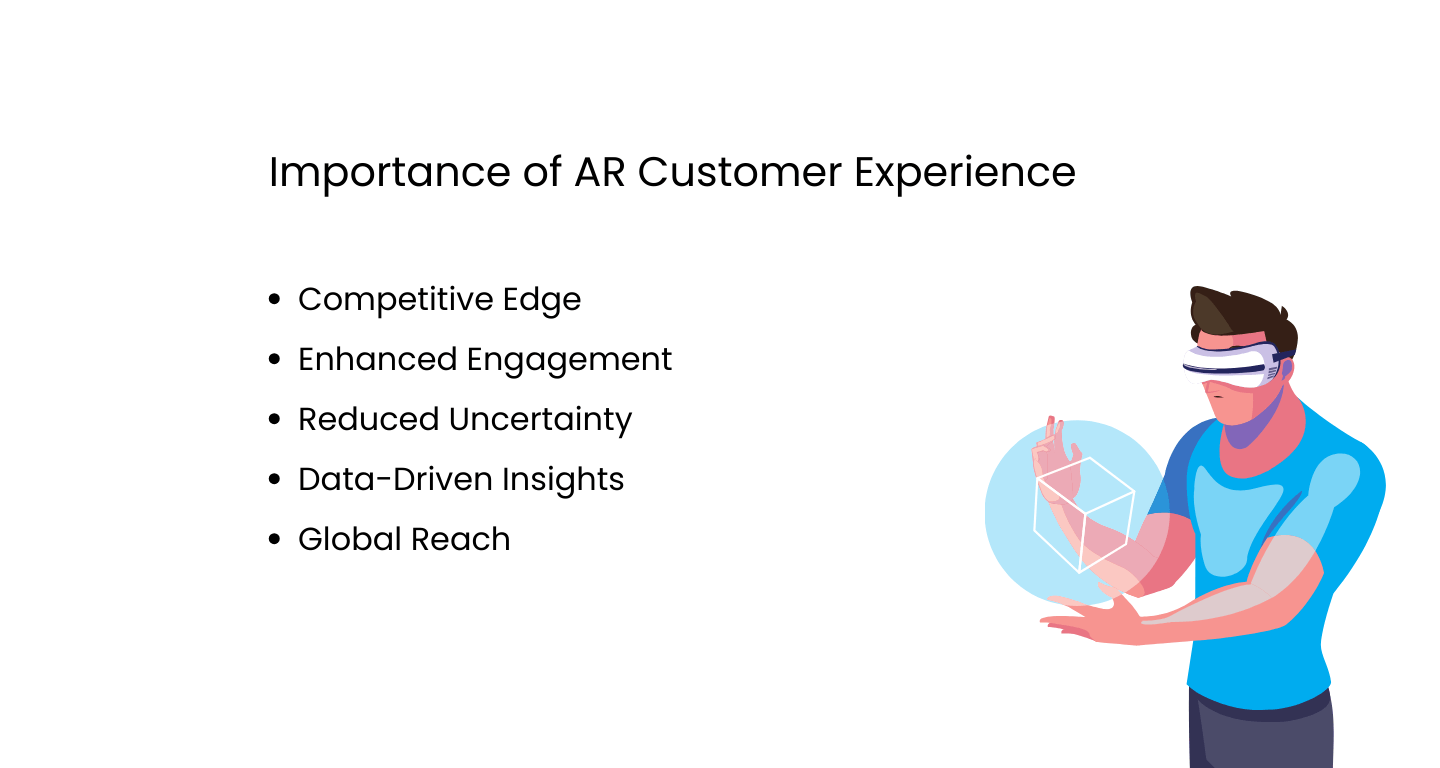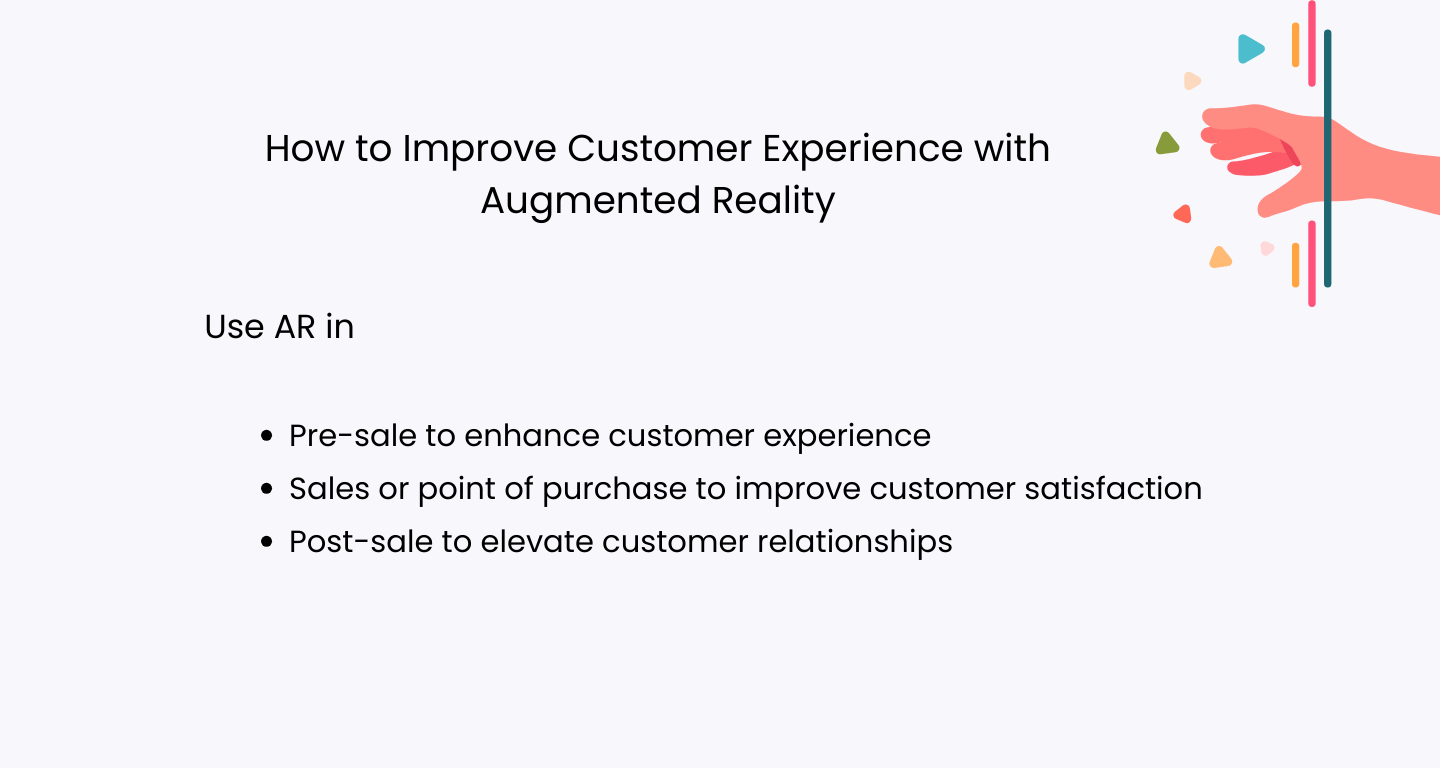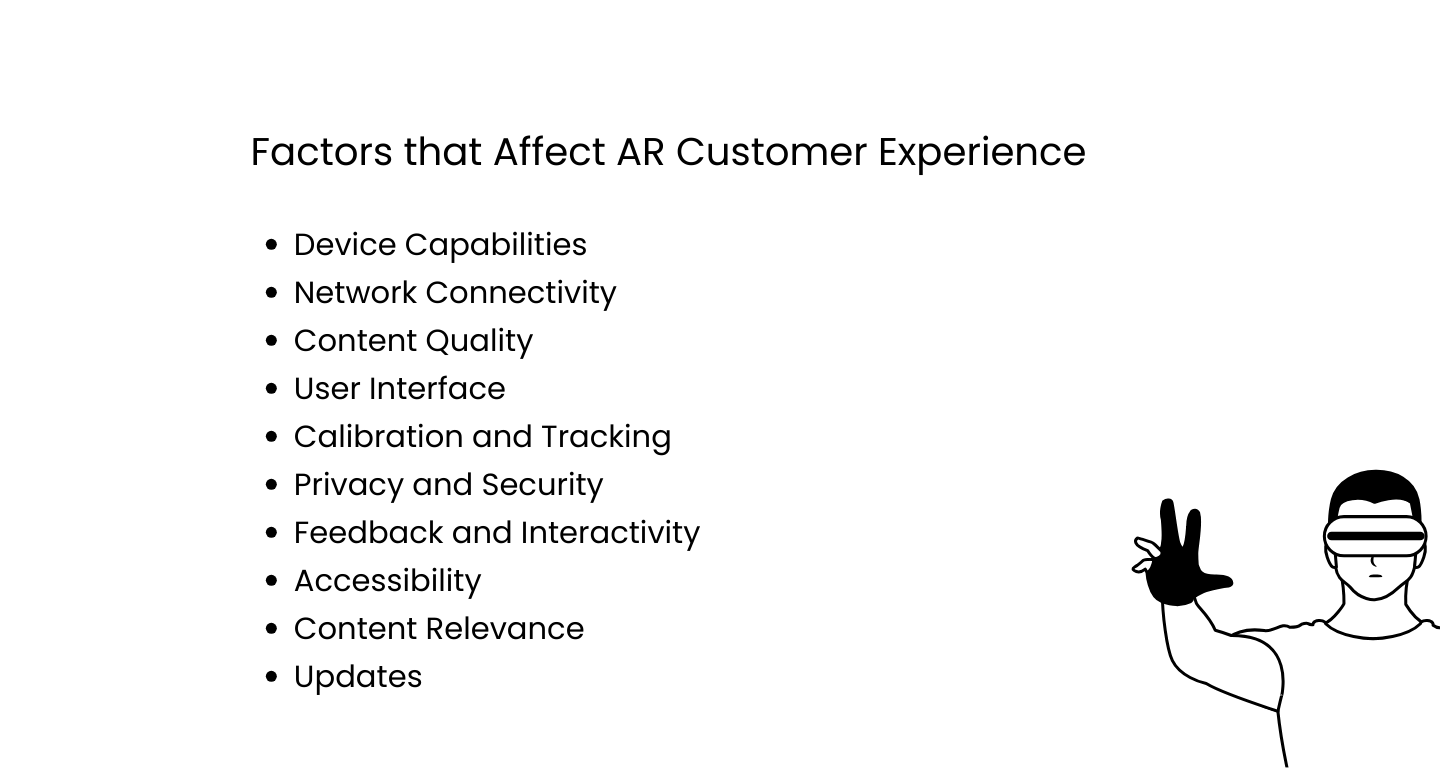Customer Experience
Augmented Reality To Enhance Customer Experience
Article written by Kate Williams
Product Marketing Manager at SurveySparrow
16 min read
19 September 2025

1-Minute Summary
AR lets shoppers virtually place products in their environment using smartphones - like seeing how furniture looks in your room before buying.
Key stats
- 71% shop more with AR experiences
- 40% higher conversion rates for businesses
- 61% prefer AR-enabled retailers
Main applications
- Virtual furniture placement (Wayfair)
- Makeup try-ons (Sephora)
- Virtual clothing fitting (GAP)
- Interactive retail experiences
Gone are the days when online shopping meant playing a dangerous game of "Will this work?" Today's smartest brands are using AR to bridge that awkward gap between "I think I want this" and "I know this is perfect for me."
Whether you're trying on lipstick without leaving your couch, seeing how a new hairstyle looks on you, or placing a 65-inch TV in your bedroom to check if it's ridiculously oversized (spoiler alert: it probably is), AR is transforming how we shop.
But this isn't just about cool tech tricks. It's about solving real problems that have frustrated shoppers for decades. It's about confidence. It's about making better decisions. And frankly, it's about time shopping got this upgrade.
Intrigued? Let’s delve in.
But what is this AR?
From the point of view of buyers:
AR or augmented reality is how buyers can visualize the product in context to their surrounding environment. AR allows the buyers to have a virtual experience of owning and using the product much before making the actual purchase.
From the point of view of sellers:
Augmented reality is a novel way of engaging with customers by providing a customized product experience in 3D. Also, it provides a contactless user interface to prospective product buyers, delivering them real-time interaction. It occurs between the real and virtual worlds through accurate 3D virtual and real objects.
By definition:
“Augmented reality (AR) is an interactive experience of a real-world environment where the objects that reside in the real world are enhanced by computer-generated perceptual information, sometimes across multiple sensory modalities, including visual, auditory, haptic, somatosensory, and olfactory.”
-Wikipedia.
“I think that a significant portion of the population of developed countries, eventually all countries, will have AR experiences every day, like eating three meals a day. It will become that much a part of you.”
-Tim Cook
What is the Augmented Reality Customer Experience?
Augmented reality customer experience is like adding a touch of magic to your shopping journey! Some of you might have already availed of this feature offered by most major brands. It’s like bringing the store to you!
So, what is it exactly?
AR customer experience uses advanced technology to let customers interact with products or services. It allows people to visualize items in their own environment. This interactive and immersive experience helps customers make better purchasing decisions and brings a touch of excitement to the journey.
It also extends to areas such as interactive packaging, virtual try-ons, immersive retail displays, and interactive user manuals.
Importance of Augmented Reality Customer Experience
Focusing on using augmented reality to improve CX is crucial if you want to gain that competitive edge. And there are several factors you should keep an eye on.

With AR,
1. Stay ahead of the game
Your focus, when it comes to CX, must be to provide an unforgettable experience. Using AR helps you stay ahead of the game by setting you apart from the rest. How? By offering immersive and innovative experiences.
2. Hook them with engaging experiences
You would love it when you are given the power to visualize products in your own space, right? AR helps you bring the store to your customers than the other way around! Plus, when they can see it, they believe it.
3. No more guesswork
It completely eliminates the uncertainty factor! Your customers can make decisions with confidence as they can try it before they buy it. This translates to higher conversion rates.
4. Data Goldmines
AR is not all about cool experiences. You gain rich insights to understand customer needs, behaviors, preferences, and interactions. Further, you can personalize marketing strategies with this data.
5. The World Is Your Market
Lastly, AR experiences know no geographical bounds. Your brand can create endless sales opportunities and reach people worldwide. It also helps you reach diverse markets.
And speaking of CX, have you heard of SurveySparrow? It streamlines your entire data collection process and provides an advanced analytics platform to make informed decisions based on the insights gained.
And, think about it – enhancing CX with AR, coupled with real-time feedback from SurveySparrow. That’s a powerful combination. Right?

Explore Deeper Customer Insights with SurveySparrow
A personalized walkthrough by our experts. No strings attached!
How Does Augmented Reality Improve Customer Experience?
Augmented reality (AR) has redefined the way customer interaction takes place. Today, AR sellers can provide a better and more engaging customer experience. The products and services are more enhanced and reality-defined. This section will educate you on how augmented reality can enhance CX at every step of the interaction.
Using AR in the latest mobile technology allows customers to experience a whole new interactive world of products and services. This digital experience transforms the overall customer relationship. Augmented reality provides an opportunity to enhance customer experience during pre-sales, sales, and post-sales.

1. Use of AR in Pre-sale to enhance customer experience:
Pre-sale is the phase when the prospect is yet to become your customer.
This phase is of utmost significance to the sellers, as this is when a prospect converts into a customer. So, we will guide you through multiple ways AR can enhance customer experience over here.
(a) AR helps the prospects to ease their decision-making regarding products or services:
Suppose you want to purchase a piece of furniture but are unsure how it will fit your interiors. Using AR, the seller can free your mind of this confusion and provide you with a virtual makeover of your interiors.
In this way, the prospective buyer can visualize the future existence of the furniture in his room much before he makes the actual purchase. And all this magic takes place on the small screen of your smartphone. Example: Wayfair 3D room app
(b) AR guides the shoppers to identify the trend
We all know how significant peer pressure is in determining the final purchase decision. Application of AR can help the prospect identify the trends in the market by actually watching the number of likes getting updated every moment of each product present in the showroom.
Example: Brazilian fashion brand C&A displays its apparel on augmented reality-enabled hangers. These hangers thus display the likes collected through social media sites for their product.
(c) Interactive packaging technology
Using augmented reality on the product packaging enhances customer experience and also strengthens customer relationships. Using AR can either show the means of using the product in multiple ways or provide more in-depth information related to the product.
For instance, the packaging of Heinz ketchup. The pack uses AR to give the buyer numerous recipes where the Heinz product is usable. This interactive recipe demonstration improves the Cx
2. Use of AR in sales or point of purchase to improve customer satisfaction:
The point of purchase is when the shoppers make a check out by making the payment for the purchased product. It takes place both online and offline. There are moments when, even during this POP, the buyers abandon their cart product and discontinue or shift their shopping.
To avoid such unwanted experiences, sellers use AR to keep their buyers focused and engaged in processing their purchases. Here are a few ways and examples to clarify the same.
(a) AR offers the try-before-you-buy customer experience
The try-before-you-buy experience, as offered by augmented reality technology, is doing wonders for the beauty industry. Every woman who loves makeup also loves to try the opportunity to experience its application before making the final purchase.
For example, the Sephora Virtual Artist AR app allows its consumers to virtually “try on” their makeup choice.
(b) AR offers the virtual dressing rooms
Make use of AR apps to make shopping for apparel easier. AR frees the buyer’s mind from any confusion regarding the look and attire of the clothing on him.
For example, GAP’s virtual dressing room app allows its buyers to choose a dress of their choice and filter the size and body type. After that, a 3D figurine will come in front dressed in the apparel of your choice to give a look-alike experience.
(c) AR offers an interactive retail experience
To keep the prospective buyers thoroughly engaged during the point of purchase, sellers use interactive AR technology. Through this technology, the buyers present in the retail outlet can dive deeper into the seller’s world of product and ambience.
For example, Starbucks’ flagship Roastery, Shanghai, lets its visitors use their smartphone to unlock visuals and information about store products. It also allows them to acknowledge themselves with the roasting process.
3. Use of AR in post-sale to elevate customer relationships
Post-sale customer relationship is essential to improve customer relationships, earn customer loyalty, and ensure future purchase. Using augmented reality during this phase adds wonders to the customer experience as offered by the brand.
(a) AR self-service support
Consumers prefer minimal interaction with the customer support team after purchasing the product. They like self-service support. And AR can make this easier.
With the simple use of a smartphone, one can access the product FAQs and manuals. AR-based self-service support widely applies across multiple smart home applications.
(b) AR technical support
AR-based visual support eliminates the long-duration technical support calls between the customer and agent. It is beneficial for both the agents and customers.
On having a technical issue, the buyer can contact the technical team and explain the problem by simply holding the smartphone. This enables the agents to access all the product details and immediately provide a solution.
(c) AR user manuals
Say goodbye to the days when the purchase of electronics or white goods or vehicles brought along the book of the user manual. No one wants to waste time flipping the pages of 5 font-size text. Use AR-enabled manuals, which provide a more personalized feel to the buyers.
Factors that Affect Augmented Reality Customer Experience
We have identified the factors that significantly impact customer experience when using AR. Take a look:

- Device Capabilities: High-quality cameras, sensors, and processing power provide seamless AR interaction.
- Network Connectivity: Stable internet is crucial for real-time AR experiences.
- Content Quality: Well-designed 3D models enhance user immersion.
- User Interface: Clear instructions, easy navigation, and interactive elements create a positive user experience.
- Calibration and Tracking: Accurate alignment of virtual and real-world objects.
- Privacy and Security: Transparent data usage policies build user trust.
- Feedback and Interactivity: Real-time feedback and interactive features engage users.
- Accessibility: Inclusive design ensures AR experiences are accessible to all.
- Content Relevance: Personalized content tailored to user interests.
- Updates: Lastly, regular updates maintain compatibility and improve performance.
Augmented reality statistics that redefine the online retail business
(a) 71 percent of consumers shop more when they can have an AR experience for the product
Augmented reality provides a fresh look and virtual feel to the consumers for the products and services. This, in a way, upgrades the buyer’s confidence in making buying decisions and improves customer experience and customer satisfaction.
(b) 61 percent of the shoppers prefer retailers who provide AR experience
A consumer gets more inclined to make a particular purchase when he is confident about the product. This confidence gets more strong when sellers enable them with augmented reality technology.
AR allows consumers to have a virtual preview of the product in their real surroundings. Thus leading to minimized returns and minimal wasted logistics costs.
(c) Mobile AR active users will be 1.73 billion by 2024
AR redefines how buyers and sellers will behave in the future retail market. This means there will be significant use of augmented reality by retailers to direct consumer traffic and conclude sales.
(d) 40% of consumers are ready to pay an extra price for AR-configured and customizable products
AR compensates for the touch-and-feel experience offline shopping offers to customers. It elevates the shopping experience one step further by providing the actual feel of the virtual product in their personal space.
(e) 1.4 billion consumers made use of AR to shop in 2023
2023 was the year when more number of people shifted to AR-driven online shopping. And today, the scenario is such that people refrain from shifting their AR experience.
(f) 32% of consumers use augmented reality while shopping
it was noted that there is a remarkable use of AR by 32% of consumers while shopping. AR thus presents a unique opportunity to improve customer experience and focus on the consumers at multiple selling points of the product.
(g) 90M of US consumers used AR monthly in 2023
According to a study by 2023, 90 million consumers in the US used AR monthly. This makes AR a significant tactic to use across all points of marketing and sales product engagement.
(h) 70% of consumers belonging to the age group of 16 to 44 years old are aware of AR
AR has soon made its way into the hearts, minds, and personal space of prospective buyers. People belonging to the age group of 16 to 44 years are aware of the applications and benefits of AR.
(i) AR improves the conversion rate by 40%
As discussed above, AR does enhance the customer experience to a great extent at each point of contact. Therefore, it improves the overall conversion rate of prospects into buyers by 40 percent.
“AR is going to become ubiquitous to the point of becoming an integrated expectation of the buying experience. Brands that want to connect with customers today and tomorrow need to move now on AR.”
-Ben Houston – Founder, Threekit
The three prime benefits of augmented reality to customers
1. Contactless shopping:
Considering the pandemic situation that currently prevails, this benefit is of utmost significance. Retailers who have inculcated the AR trends allow their consumers to try their products before making the final purchase virtually.
Here is an example from the world-famous fashion brand Gucci. Gucci partnered with Snapchat to allow their consumers to try on the sneakers virtually before buying them.
2. Immersive experiences that enhance product utility:
AR-integrated brands make their prospects dive deep into their world. It strengthens the immersive experience offered by brands. In the words of Dobrian Dobrev, UX architect for Coca-Cola’s IT marketing team,
“This technology is here to stay, and we need to adapt accordingly in order to remain relevant and be efficient, creative problem solvers.”
3. Unprecedented personalization:
Every consumer gets excited when the brand extends the level of personalization offered to him. AR makes this possible in a much more convenient and impactful way.
For instance, take Disney. The brand allows the kids to color and visualize their colored images in 3D form with the help of augmented reality.
Augmented reality at the point of field service, contact centers, and self-service
Google forecasts that augmented reality will touch the mark of $80 billion markets by 2025. This, therefore, emphasizes the massive role played by technology to offer a positive customer experience.
Seventy percent of the consumers have clearly defined the benefits of using AR in their routine life and shopping. Therefore, AR helps consumers meet their demands with augmented excellence, especially at the point of field service, contact centers, and self-service.
AR, therefore, enables field service experts using field service management software to provide remote customer help with the simple use of a smartphone. This also compensates for any technical errors, improves the training sessions, and increases first-time resolutions.
At the point of contact centers, augmented reality empowers the agents to interact visually with customers. This leads to increased efficiency, reduced drain of resources, and enhanced customer experiences through personalized visual guidance.
Augmented reality-enabled self-service allows customers to use their smartphones to access their product’s knowledge, FAQs, and manuals. It encourages customers to resolve their problems themselves. This, in a way, improves self-service efficiency and reduces the contact center volume and the cost of technician visits.
Challenges of Using Augmented Reality
Just as AR has its own benefits, there are some pitfalls when we use it to improve customer experience.
Tech Compatibility: Some devices may not support AR. Not everyone has the latest gadgets, so not everyone can enjoy the AR features.
Tricky to Use: Yes, if it’s not designed well, it can be confusing. People might find it difficult to understand or use, leading to frustration.
Privacy Worries: AR applications often require access to personal data. This can raise concerns regarding user privacy. As a result, people want assurances that their personal information is being protected.
Internet Dependence: AR heavily relies on the internet. If your connection is weak or lost, the AR experience can get disrupted, making it less enjoyable.
Too Much, Too Fast: Overloading the features without a clear purpose can confuse users. Too many things happening at once can overwhelm your customers. Also, it’s possible they might become unsure of where to focus or what to do.
Wrapping up…
Today, consumer behavior has changed drastically. Consumers and retailers have realized the significance of augmented reality. Considering the level of improvement that comes with augmented reality, the retailers have imbibed AR at multiple points of purchase.
The worldwide retail market has experienced a decade of new experiences within a few months.
Because of the pandemic fear, people are reluctant to touch and experience the product personally; instead, they prefer a more in-depth AR approach. As a result, physical stores and outlets had a hard hit, whereas the e-commerce industry experienced a sudden spike. Courtesy, the AR-enabled technical drift. So, brands that are shying away from AR are the ones to lose their customers to the AR field competitors. Beware! Consumers have elevated their shopping standards.
So, is your organization ready to embrace AR success? Are you prepared with your share of research and analysis to support the AR drive? If not, you need to click SurveySparrow. We will provide you with everything your firm requires to enhance customer experience.
Make sure your AR initiatives align perfectly with customer expectations. Sign up today!

Explore Deeper Customer Insights with SurveySparrow
A personalized walkthrough by our experts. No strings attached!

Make your customers feel heard. Turn feedback into loyalty with SurveySparrow's CX platform.
Kate Williams
Excels in empowering visionary companies through storytelling and strategic go-to-market planning. With extensive experience in product marketing and customer experience management, she is an accomplished author, podcast host, and mentor, sharing her expertise across diverse platforms and audiences.
Frequently Asked Questions (FAQs)
It's technology that lets you see how products would look or work in your real environment using your smartphone or tablet. Think of virtually placing a sofa in your living room or trying on makeup without visiting a store.
Most AR experiences work with regular smartphones and tablets. You just need a device with a decent camera and processing power. No special glasses or expensive equipment required for most retail AR applications.
Modern AR is quite accurate for size, fit, and appearance, but it's not 100% perfect. It's best used as a helpful guide rather than a complete replacement for physical trials. Most users find it significantly reduces uncertainty about purchases.
Reputable retailers follow strict privacy policies, but AR apps do collect data about your environment and preferences. Always check privacy settings and only use AR features from trusted brands. Look for clear data usage policies.
AR performance depends on your device's processing power, camera quality, and internet speed. Older devices or poor network connections can cause lag. The complexity of the 3D models also affects performance.
AR overlays digital content onto your real environment (like placing virtual furniture in your actual room), while VR creates a completely virtual environment. AR is more practical for everyday shopping as you can use your phone anywhere.
Yes! Studies show AR significantly reduces return rates because customers make more informed decisions. When you can see how something looks in your space or on you, you're less likely to be disappointed with the actual product.
Related Articles

Customer Experience
What Is Customer Feedback Management? A Complete Guide
13 MINUTES
26 December 2025

Customer Experience
Customer Journey Map: Meaning, Types and Benefits
12 MINUTES
18 May 2018

Customer Experience
9 Tips to Devise the Best Customer Loyalty Programs in 2018
9 MINUTES
27 June 2018

Customer Experience
5 Real-Life Customer Support Examples You Should Not Miss!
14 MINUTES
29 September 2020
